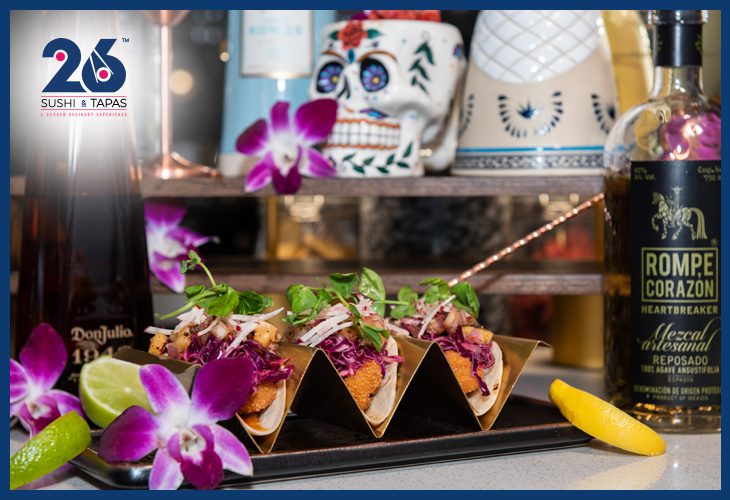Curious about the intriguing realm of tequila? Here, you can explore its rich history and the meticulous process of crafting this beloved Mexican elixir while tasting our exceptional dishes that blend Japanese and Latin flavors. Grab a glass, raise a toast, and read on!
The vicinity of the city of Tequila, about 65 kilometers northwest of Guadalajara, is where most tequila comes from. The liquor can only be made in these parts of Mexico for it to be considered a true tequila.
Because of the historical and cultural importance of the region near Tequila, it was listed as a UNESCO World Heritage Site in 2006, called the Agave Landscape and Ancient Industrial Facilities of Tequila.
Here are some of the most fascinating tequila facts you should know.
1. Tequila is not made from a type of cactus.
People often mistake the agave plant for a type of cactus. The truth is, agave is part of the succulent Agavoideae family, which is closely related to the Liliaceae or lily family.
The Weber blue agave plant also resembles an aloe vera plant, except that it is much larger with sharp barbs on its tips.
2. Only the heart of the agave plant is used to make tequila.
The agave plant’s heart is called “piña,” which looks like a pineapple, hence the name.
When making tequila, only the piñas of the agave plants are used. They are cut out and cooked, then ground down and fermented.
3. Tequila is mezcal made using only blue agave.
Most people get confused, thinking mezcal is a type of tequila when, in fact, it is the other way around.
Mezcal is another popular Mexican liquor. It is made with different kinds of agave plants. Tequila, on the other hand, only uses the blue agave variety.
4. Tequila’s history dates back to 250 to 300 A.D.
Another interesting information about tequila is how old it is, dating as far back to 250 to 300 A.D.
Aztec Indians created a fermented juice of the agave plant, which they used for their ceremonial wine. This was called pulque, tequila’s predecessor. It was believed to be an important part of their diet.
The first documentation of this beverage was engraved on stone walls, appearing around 200 A.D. and catching on centuries later, when the Spanish came to conquer the land of the Aztecs and tried to distill the drink.
5. The first commercial distillation of tequila was made in 1758.
The Cuervo family did it, which is what we now know to be the modern tequila. Today, Jose Cuervo is the oldest and the most famous tequila brand the world knows. Their distillery in Tequila, Jalisco, welcomes visitors for guided tours and tasting of the highest-quality tequila.
6. In 1974, it was declared illegal for Mexican states besides Jalisco to produce and sell their own “tequila.”

Tequila has an appellation of origin just like some fine wines. Besides the largest and most significant producer Jalisco, tequila can also be produced in Tamaulipas, Guanajuato, Nayarit, and Michoacán.
In 1974, however, the government of Mexico made it illegal for all the other states outside Jalisco to make and sell this tequila. They also declared the word “tequila” as an intellectual property of Mexico.
7. Tequila is the world’s most regulated liquor.
That’s correct, because every Weber agave plant used to make this fabulous drink is numbered and registered. This is done by the Norma Oficial Mexicana (NOM) and it applies to all processes and activities related to the tequila business: from production and bottling to marketing and other practices.
The NOM insists that the liquor will only be called “tequila” if it is produced in the aforementioned regions of Mexico, especially Jalisco.
8. Tequila found outside of Mexico is called “mixto.”
Suffice it to say, it’s not real tequila so it’s got quite a bad rep. “Mixto” has up to 49% sugar that comes from somewhere else, not the blue agave. It can come from cane, beet, and even corn syrup.
For the real thing, look for the “100% agave” label.
9. There is a National Tequila Day (and it was not created by Mexicans).
The 24th of July is dedicated to drinking and enjoying tequila. While tequila is truly Mexican, this special day was not created by Mexicans but Americans who love this drink as much as the Mexicans and the rest of the world do.
National Tequila Day is celebrated with free-flowing tequila and lots of music, especially mariachi bands.
10. Tequila may actually be good for your health.
Tequila is thought to have something to do with weight loss because the molecules in agavins (which makes up tequila) stimulate the metabolism. A post-meal shot of this Mexican booze may also help stimulate digestion.
In addition, tequila is said to possibly have the ability to lower bad cholesterol and raise the good one, so it could be good for the heart.
11. Tequila can be turned into diamonds.
Here’s one of the most fun trivia about tequila: It can be turned into diamonds.
That’s right, according to a team of Mexican scientists that experimented with various organic solutions. They discovered that the 80-proof tequila blanco (40% alcohol) has the best ratio of ethanol to water that can be used to manufacture synthetic diamonds. This is done by depositing the tequila on a silicon or stainless steel substrate.
Sadly, however, these “tequila” diamond films produced are too small to use in making jewelry.
12. There are no worms in the bottles of tequila.
Worms in tequila are a myth, said to be just a gimmick. Worms are actually found in mezcal. Rest assured that the tequila regulatory council doesn’t allow worms and other creatures (such as scorpions) to be added to tequila.
13. Margarita is the most popular tequila cocktail.
Margarita is a cocktail made up of tequila, triple sec (orange-flavored liquor), and lime juice. It is often served with salt on the glass rim and served shaken with or without ice. It is typically served in a margarita glass, which is a variant of a champagne flute or cocktail glass.
There are other popular cocktails made with tequila such as tequila sunrise (tequila mixed with orange juice and grenadine syrup, served in a tall glass), the Bloody Maria (similar to the Bloody Mary – except tequila is used instead of vodka), and the traditional drink in Jalisco – the Cantarito (tequila with grapefruit, grapefruit soda, lime and orange juices, and salt).
14. Mexico exports between 200 and over 300 million liters of tequila annually.
… and Jose Cuervo remains the leader in the tequila industry.
The volume of tequila that Mexico exports to the rest of the world has been constantly increasing in the recent years. In 2021 alone, the volume had reached close to 340 million liters.
The biggest tequila consumers are the Americans, followed by the Germans (with a huge margin of 44x less the volume than Mexico’s neighbor).
15. Mexicans enjoy tequila neat.
And they also often sip the drink and take time savoring the flavor.
In the United States (and perhaps the rest of the world), on the other hand, they like to take their tequila shot with salt and lime to lessen the liquor’s burn. The sourness of the lime fruit is said to balance and enhance the flavor of this fantastic Mexican booze.
26 Sushi & Tapas offers an unforgettable dining experience where the delicate art of sushi and tapas can be complemented by the rich and nuanced spirit of tequila! Follow us on Instagram @26sushi_tapas to stay up to date on our menu specials and events, and order online or make reservations at 305-570-2626.
Reference: [https://journeytomexico.com/facts-about-tequila/]


